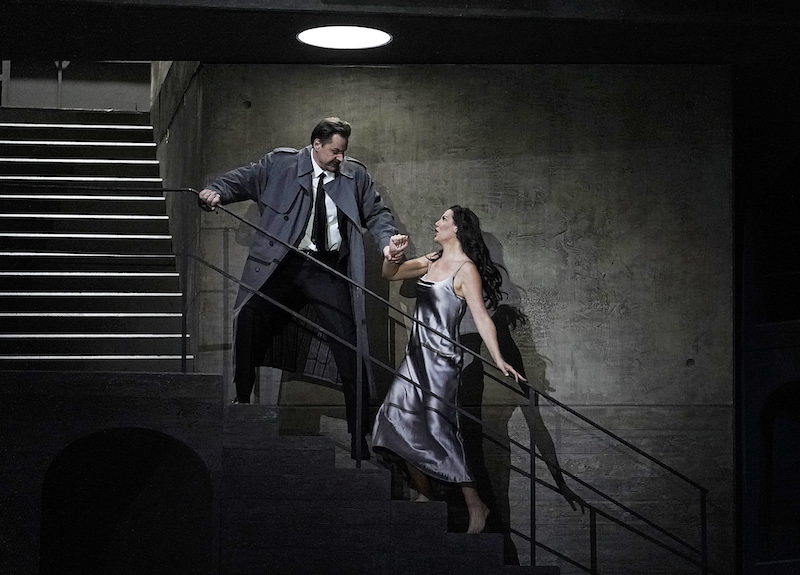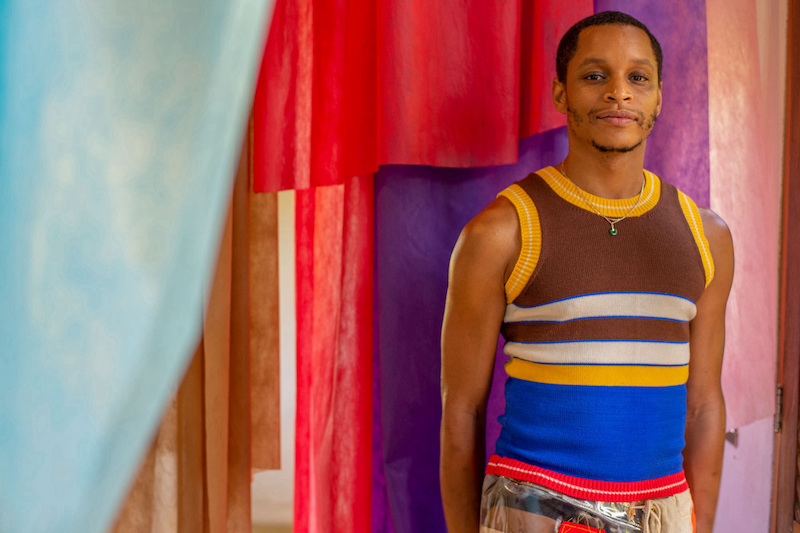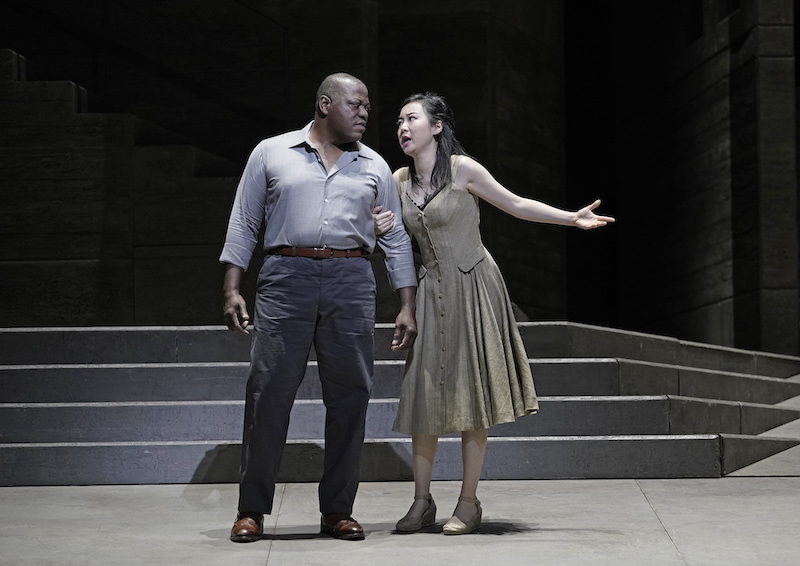
Photography by Karen Almond. Image courtesy of the Metropolitan Opera.
Welcome to “A Night at the Opera,” a bi-monthly column dedicated to demystifying the art form for the Aida-curious and the Ring Cycle-indoctrinated alike. Along the way, you can expect gossip from the champagne line, epiphanies at intermission, and critiques courtesy of CULTURED's Editor-at-Large Kat Herriman, and the magazine’s favorite artists, designers, actors, and writers. In this installment, Herriman is joined by the artist Devin N. Morris at the Met Opera’s presentation of Don Giovanni for a deliciously rich performance with soulless aesthetics.
There are few people whose outfits I look forward to. Artist Devin N. Morris is one of them. Immaculate would be the word I’d use. Everything is pressed, tailored, and styled in a way that flirts with perfectionism without submitting to its regime. Morris takes the same care when it comes to his paintings and sculptures, which he dresses and attends to as a costume designer might, with materials both found and assembled. Morris’s studio is an atelier for the inanimate.

When we attend Ivo van Hove’s production of Don Giovanni at the Metropolitan Opera, Morris doesn’t disappoint. He conjures the image of a slick and priestly Don Juan in jet-black sailor pants and a spotless Cacharel mock-neck. For once, my date is the best dressed in the place, but we still look around for competition—the gowned dames pushing their way through sandwich bag toting regulars—as we down our champagne before the curtain rises.
Our plastic flutes with their removal bases are a visual synecdoche for the whole opera house. Yes, there is glamor here to be imbibed, but it is a precarious kind. It demands participation from the cast, the ushers, the audience, and the building itself. In other words, you have to hold the glass from the bottom. Otherwise, the coupe turns back into a cup, and the champagne into Martinelli’s.
I like Anna Dezeuze's definition of precarity in her book on artist Thomas Hirschhorn’s Deleuze Monument, 2000. She traces the word all the way back to its root—the Latin word for pray, whose entry in the Oxford English Dictionary reads: “to be held or enjoyed by the favor of and at the pleasure of another person.” Dezeuze asserts that precarious art is work that ”effectively dramatizes its existence as a material object that needs to be recognized by others.” She goes on to distinguish this from ephemeral artworks like Robert Smithson’s Spiral Jetty, 1970, which are subject to the indifference of an unconscious nature rather than the premeditated actions and instincts of individuals. By Dezeuze’s standards, opera is perhaps the ultimate precarious form; every night it must fight for its survival, not against the elements but at the “intersection of reality, politics, and aesthetics.” One outlaw sniggering or coughing in the dark can ripple through the theater, break the spell, and spoil the night. This, of course, is just one of the many ways it can all go wrong.

Photography by Karen Almond. Image courtesy of the Metropolitan Opera.
I want to run this hypothesis by Devin, but the darkness is closing in on us and Nathalie Stutzmann, the Met’s hyped-up new conductor, has taken her place at the stand. Luckily, [Wolfgang Amadeus] Mozart’s Don Giovanni is there to try on my suspicions. The titular character, played by Peter Mattei, bursts onto the scene bragging about his female conquests while he lays a web of new tricks and seductions. His slutty lifestyle is held together solely by other people’s belief in his high-born intentions and the ability of his wing man, Leporello (played by Adam Plachetka), to avert his gaze.
This lusty soufflé is already collapsing in on itself before the first act is up. Don Giovanni can capture women's obsession and spoil their marriages, but he cannot seem to sustain his own pleasure. He is a love addict, and, in his greedy desperation, he loses control of the ensemble he’s cast. Stutzmann, on the other hand, holds them close. By intermission that is all Morris and I are discussing. The performances are tight tonight, maybe some of the tightest I’ve ever seen at Lincoln Center. We agree that the loosely 1940s inflected costuming and minimalist faux concrete set are a shame, because the performances are so exquisitely rich and textured that the visuals feel too anemic to support them. It’s stylish without soul, like some really well-made sheath dress from The Row.

Morris and I aren’t The Row’s target audience nor are we Don Giovanni’s. But, as a serial monogamist with more adventurous friends, I recognize some of the motifs and plotlines his bad behavior teases out. We are especially tickled by Zerlina (played by Ying Fang) trying to reel back in her scorned fiance Masetto (played by Alfred Walker), who is rightfully suspicious of what’s been going on between nobleman Don Giovanni and his bride-to-be. Zerlina begs Masetto to hit her—if only to skip to the end of the fight. “She’s the only woman in the whole show with an opinion, and we will never know what it is,” notes Morris.
Every other lover’s desires are clear; Zerlina’s aims are not. She promises Masetto she can weather whatever he throws at her as long as they can reclaim their former love, but even this declaration is a kind of concealment. Why should he hit her? She has not pursued Don Giovanni, nor does she return his advances. But has she betrayed Masetto in other ways? Is questioning whether you are in the right relationship a kind of transgression? Is your doubt enough to break the precarity of another’s pleasure?

Photography by Karen Almond. Image courtesy of the Metropolitan Opera.
Mozart leaves that up to us, and Don Giovanni to the devil who is conjured on stage. With a sharp turn towards projected graphics, copulating bodies resembling leaping flames swallow the minimalist stage whole in the final minutes of the show. Don Giovanni is lost to hell.
When the lights come back up, the stage is no longer a graytone wasteland, but a town bursting with the trappings of life: flower boxes, lines of laundry, and places to sit. All the decorative bits, bobs, and excrescences of ourselves that Morris has spent his career trying to draw our attention to. It is a dramatic transformation that is supposed to make us think about what has been lost and won. The opera has the opposite effect on Morris and me. “I don’t think it’s communicating what they think it is,” says Morris. Don Giovanni may have been a man made of snips and fibs, but he threw the rest of their goodness into color. Without him, the stage feels lifeless. It’s not always the beautiful things that make something special but the ugly bits as well. What is the opera without its corny theatricality, its plasticities, and its haters? Not much.










 in your life?
in your life?

